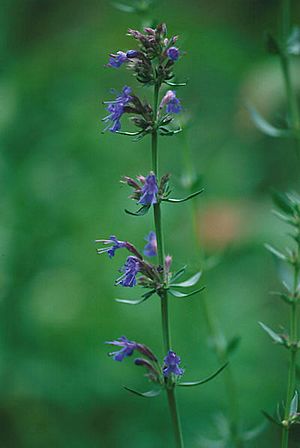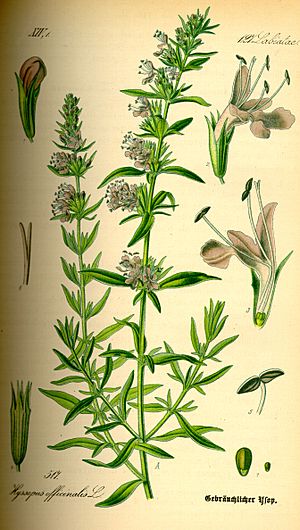Hyssop facts for kids
Quick facts for kids Hyssop |
|
|---|---|
 |
|
| Herb Hyssop Hyssopus officinalis | |
| Scientific classification | |
| Kingdom: | |
| (unranked): | |
| (unranked): | |
| (unranked): | |
| Order: | |
| Family: | |
| Genus: |
Hyssopus
L.
|
| Species | |
|
See text |
|
Hyssop (Hyssopus) is a group of about 10 to 12 types of plants. These plants are either soft and green (herbaceous) or slightly woody (semi-woody). They belong to the Lamiaceae family, which is also known as the mint family.
Hyssop plants originally grew in the area from the eastern Mediterranean Sea to central Asia. They have a nice smell and grow upright with branched stems. These stems can be up to 60 centimeters (about 2 feet) long. Their tips are covered with tiny hairs. The leaves are shaped like narrow ovals and are about 2–5 centimeters long. Small blue flowers appear on the upper parts of the branches during the summer. The most famous type is the Herb Hyssop (H. officinalis). It is grown in many places outside its natural home in the Mediterranean.
It's important to know that anise hyssop (Agastache foeniculum) is a different plant. Even though it's also in the mint family, it's not closely related to true hyssop. Anise hyssop grows naturally in many parts of north-central and northern North America.
Contents
How to Grow Hyssop Plants
The name 'hyssop' has a long history. It comes from the Greek word hyssopos and the Hebrew word ezov. Hyssop seeds are usually planted in the spring. Once they grow into small plants, they should be planted about 40–50 centimeters (about 1.5 feet) apart.
You can also grow new hyssop plants from cuttings or by dividing their roots. This can be done in the spring or autumn. Hyssop needs a lot of sunlight and soil that drains water well. Trimming the plants now and then helps them grow better. Hyssop plants don't live for a very long time, so you might need to replace them every few years. They are great for creating a low border or hedge in a herb garden.
Hyssop in the Garden
Hyssop is also useful in the garden for other reasons. Many people believe it's a good companion plant for cabbage. This is because it can help keep away the Cabbage White butterfly, which can harm cabbage plants.
Hyssop has also been shown to help grapevines grow better. This is especially true if the grapevines are planted in rocky or sandy soil that is hard to work with. However, hyssop is said to be bad for radishes, so you should not plant them close together.
Hyssop flowers attract bees, hoverflies, and butterflies. This makes it a good plant for a wild garden. It helps control pests and encourages pollination naturally.
Drying Hyssop Leaves
You can keep hyssop leaves for a long time by drying them. The best time to pick the leaves is on a dry day when the plant is fully grown. This is when it has the most active ingredients. The leaves should be dried quickly, away from bright sunlight. This helps them keep their good smell and prevents other chemicals from changing.
Good air circulation is important for drying. You can use a warm place like an airing cupboard with the door open, or a sunny room. Aim for a temperature between 20-32°C (68-90°F). Hyssop leaves should dry in about six days. If they take longer, they might change color and lose their flavor. Once dry, store the leaves in clean, dry, airtight containers. They will stay good for about 12 to 18 months.
The larvae (young forms) of some Lepidoptera species, like the Cabbage moth, eat hyssop plants.
Uses of Hyssop
Hyssop is used in many different products. It is an ingredient in eau de Cologne, which is a type of perfume. It is also found in the liqueur called Chartreuse. Hyssop is used to give color to the drink Absinthe, along with the Melissa plant and Roman wormwood.
Hyssop is often used in natural remedies, usually mixed with other herbs like liquorice. It is especially helpful for lung problems. Hyssop can also help fight bacteria, make tiny blood vessels (capillaries) stronger, and reduce swelling. It is believed to help with many different health issues, including bronchitis, trouble sleeping (insomnia), swelling (edema), and colds.
When taken as an extract or tea, hyssop can help clear mucus from your breathing passages. This can relieve stuffy noses and chests. It may also help control blood pressure and get rid of gas. Some people use it for problems with blood flow, epilepsy, fever, gout, and weight management. Fresh hyssop can be made into a soft, moist pack (poultice) to help heal wounds. However, it should not be used during pregnancy.
Hyssop in Ancient Traditions
Hyssop is considered a special plant in Judaism. It is mentioned many times in the Hebrew Bible as Ezov. In the Book of Exodus, people in Egypt were told to use a bunch of hyssop. They were to dip it in blood and put the blood on their doorframes.
Priests in the Temple of Solomon used hyssop for cleaning ceremonies. This is described in the Book of Leviticus. Hyssop is also often used in the Catholic Church. Priests dip a special tool called an Aspergillum into holy water and sprinkle it on people to bless them. This tool is often filled with hyssop.
However, some researchers believe that the plant mentioned in the Bible might not be the same hyssop we know today. It could have been a different type of herb. The Talmud, a collection of Jewish teachings, calls hyssop abarta. It says hyssop is a natural remedy for indigestion.
Hyssop in Food
Hyssop leaves have a slightly bitter taste, similar to mint. You can add them to soups, salads, or meat dishes. But be careful, as the flavor is very strong, so use only a small amount.
Related Plants
- Agastache, also known as Giant Hyssop
Gallery
See also
 In Spanish: Hyssopus officinalis para niños
In Spanish: Hyssopus officinalis para niños





